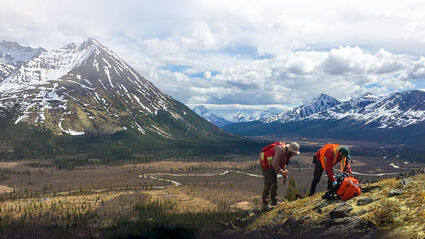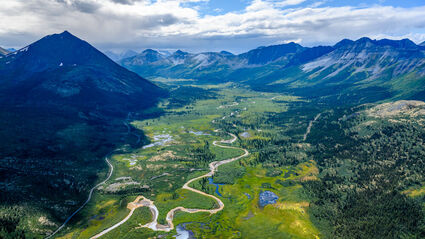A year of explosive growth for Fireweed
Adds critical metal projects and expands into NWT during 2022 Mining Explorers 2022 - January 19, 2023
Last updated 1/26/2023 at 6:55pm

Fireweed Metals Corp.
Fireweed Metals' Macmillan Pass project in the Yukon hosts more than half a dozen highly prospective zinc targets.
Whether it is expanding its zinc-lead-silver resources on its flagship Macmillan Pass project in the Yukon, gaining a better understanding of its newly acquired Mactung tungsten project straddling the Yukon-Northwest Territories border, or carrying out reconnaissance exploration of its newly added Gayna River zinc-lead-gallium-germanium project within NWT, appropriately named Fireweed Metals Corp. decided Fireweed Zinc just would not cut it and changed accordingly.
Comprised of a road-accessible project adjacent to Yukon's border with NWT, the 544-square-kilometer (210 square miles) Macmillan Pass project blankets a roughly 55-kilometer (34 miles) trend of zinc, lead, and silver mineralization.
Two of its more advanced deposits – Tom and Jason – host 11.2 million metric tons of indicated resource averaging 6.59% (1.63 billion pounds) zinc, 2.48% (620 million lb) lead, and 21.33 grams per metric ton (7.7 million ounces) silver; plus 39.5 million metric tons of inferred resource averaging 5.84% (5.08 billion lb) zinc, 3.14% (2.73 billion lb) lead, and 38.15 g/t (48.4 million oz) silver.
However, moving into 2021, Fireweed reported exciting news from a third area with the potential to eclipse Tom and Jason – Boundary.
Located roughly 15-road-kilometers (nine miles) west of Jason, Boundary was the primary focus of the company's 2020 drilling. Upon further exploration drilling, Fireweed could not wait to announce the discovery hole from its newest Boundary West target, which cut 76.7 meters averaging 4.22% zinc, 0.34% lead, and 25.6 g/t silver.
Due to this intercept, Fireweed focused its 2021 goals on expanding this area.
Expanding metals portfolio
Kicking off 2022, while assays began to roll in from the previous year, Fireweed Metals decided to add not one but two new properties to its quickly expanding portfolio.
Approximately 180 kilometers (112 miles) north of Fireweed's Macmillan Pass, Gayna River is located in the Mackenzie Mountains of NWT and within the asserted territory of the Na-Cho Nyäk Dun First Nation.
First discovered in the 1970s, more than 28,000 meters of drilling was carried out by Rio Tinto, which outlined a large target with abundant zinc, lead, and silver mineralization.
Despite this, Rio Tinto allowed the claims to lapse, believing there was low potential for a high-grade deposit at Gayna River.
A recent shift in thinking behind the geological model, however, led Fireweed to believe there is potential for high-grade massive sulfide zones within areas that were not tested by Rio Tinto.
Hence, Fireweed acquired 100% of the Gayna River project at a very low cost by staking an area of 12,875 hectares (31,815 acres), covering all the historic showings and anomalies.
Not even a month later, the company opted to acquire the Mactung tungsten project from the Northwest Territories government for C$15 million.
Lying within the traditional territories of the Kaska Dena and First Nation Na-Cho Nyäk Dun, as well as the Sahtu Dene and Métis land claims settlement area of western NWT, this critical metal property hosts 33 million metric tons of historical indicated resource averaging 0.88% tungsten trioxide, making it one of the largest known undeveloped, high-grade tungsten-skarn deposits in the world.
Despite Mactung's world-class size and grade, along with being advanced well into permitting, the former owner of the project, North American Tungsten, fell into financial difficulties and filed for creditor protection before it could develop the mine that would have produced roughly 6,450 metric tons of tungsten per year.
The government of Northwest Territories acquired Mactung in 2015 and obtained a Class 4 Mining Land Use Approval for the tungsten mine project in 2020.
While it was North American's loss, it became Fireweed's gain, leading it to purchase this property that borders the northeast side of its Macmillan Pass zinc-lead-silver property from the territorial government.
Biggest and best drill program
Like most northern miners, once the thaw has set, outside work can begin. Announcing the start of its drilling mid-June, Fireweed planned for its largest and most ambitious program to date.
"The main objectives of the 2022 field program will be to define and expand the known mineralized zones toward an updated mineral resource study this winter followed by an updated preliminary economic study," said Vice President of Exploration Gilles Dessureau. "We are also excited to use innovative new technologies, such as muon tomography and hyperspectral imaging to guide exploration."
Toward this goal, a 7,000-meter drilling program was planned for Macmillan in 2022.
This included 17 holes in the Boundary Zone, six at Boundary West, eight at Tom West, and one at Tom East.
"The 2022 drill program was not only our biggest, but it was our best," said Fireweed Metals CEO Brandon Macdonald. "Our drilling consistently yielded wide zones of zinc mineralization at Boundary zone, including many potentially very high-grade intervals and new discoveries."
Hitting zinc in nearly every hole, 23 diamond drill holes were collared at Boundary, including six at Boundary West and the balance of 17 at Boundary Main.
Eight infill holes were completed at Tom West, which targeted feeder mineralization to test the validity of the current geological model and improve drilling recovery in areas of historic poor drilling recovery.
All eight holes intersected the mineralized zone close to where it was predicted by the geological model.
"The first results from the 2022 program include the best intersection we have ever had at Boundary zone, or anywhere on the property including our Tom and Jason deposits," said Macdonald.
Already anticipating the results to have high to very high zinc and lead grades, even potentially greater than the grades offered in the block model of the current mineral resource estimate, the second hole drilled proved this may be the case.
Cutting an impressive 124 meters averaging 12.3% zinc, 1.3% lead, and 45.9 g/t silver, including a 60-meter subsection averaging 19% zinc, 1.6% lead, and 64.7 g/t silver, hole NB22-002 was not only impressive but also extended the known mineralization at Boundary West.
The implications of this hole spread far for Fireweed, not just for expanding mineralization, but also, based on geological vectors, suggests a feeder zone may be present in which higher grades and thicknesses may be found.
With an updated MRE in the works to include four seasons of additional drill data, including an inaugural resource for Boundary, Boundary West, End Zone, and the Tom North zones, as well as an updated resource for Tom West, Tom East, Tom Southeast and the Jason and Jason South zones, the table is full with a potential estimate that will shoot this Yukon-Northwest Territories miner into a league of its own.
And perhaps the Fireweed CEO put it best for what to expect in the coming resource update, "whether on purpose, or sometimes by accident when targeting other zones, we just can't stop finding zinc."
Jaws of Gayna River
While drilling was being carried out at MacMillan Pass, Fireweed carried out a gravity survey and sampling program at Gayna River.
This included the collection of ten samples across the Jaws anomaly, an area of very high lead-in-soil values in historical soil geochemical data. The 2022 sampling was carried out over an area with the highest historical values.
All ten samples ultimately ran over 4,000 ppm lead, including seven samples over 1% lead, one sample of 27.5% lead and 176 ppm silver, and another at 0.75% zinc, confirming the presence of a very strong soil anomaly and validating the high lead- and zinc-in-soil values in the rest of the historical soil geochemical dataset.
In addition to soil sampling, Fireweed geologists collected rock samples that confirmed the presence of high-grade zinc and lead sulfide mineralization at surface, as well as elevated concentrations of the critical minerals gallium and germanium.
Eight grab samples were analyzed in total, including dolostones, dolostone breccias, limestones, and veins.
All had grades greater than 7% zinc, and the best sample comprised 73.7% lead, 9.2% zinc, and 40.5 ppm silver.

Fireweed Metals Corp.
Macmillan Pass lies within the Mackenzie Mountains that form a natural border between Yukon and Northwest Territories.
The highest zinc grade was 51.2% in a sample that also contained 42 ppm gallium and 39 ppm germanium, with appreciable grades of gallium and germanium also being present in many of the samples, with up to 42 ppm gallium and 99 ppm germanium in different samples, notably in those with higher zinc grades.
"The results from this year's exploration program at Gayna River demonstrate that there is potential for high-grade massive sulphides here, consistent with our approach in exploring Kipushi-style high-grade targets around the margins of these ancient carbonate reefs," said Macdonald.
As for Mactung, Fireweed had field crews begin a resampling program on-site. Using historical core to measure for bulk density, as well as re-assaying them to provide key data to expound an upcoming resource estimate, Mactung saw little action while awaiting those results.
However, aside from that delay, lidar was flown successfully over the extent of the property, which Fireweed hopes will give additional critical insight into this world-class tungsten deposit.

















Reader Comments(0)